“I have some new plants, I’ll just wait till the end of winter to plant them”. I hear this often. My reply is always “No! Plant them now.”
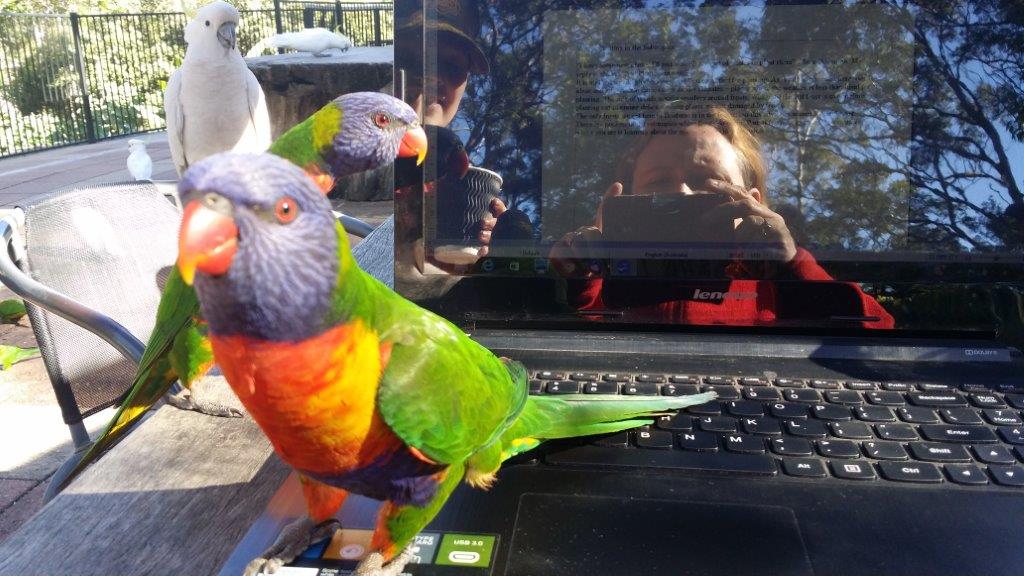
A rainbow lorikeet tried to help me write this! – as did numerous king parrots and cockatoos
It is mid winter and glorious weather! Perfect in fact for planting. As is all too common here, our ideas and information comes from colder climates – places where the weather is less than ideal for planting in mid winter. This notion revolves around frosts. Wait until the last frost is over before planting out to ensure delicate young plants are not damaged by frosts. Makes sense, except when the only frost you get is in the freezer, in which case, however good this advice, it simply does not apply.
There are pockets in the subtropics where frosts do occur. Part of learning to garden, no matter where you are, is learning about the microclimates in your patch.
When I teach subtropical gardening, I always ask –
“do you get frosts in your garden”?
I get the occasional yes, but not many. Frost does govern the way we garden as it can be very damaging to plants. Those who do get frosts around here tend to get very mild frosts. These do allow them to grow more temperate plants than the rest of us, but are not usually severe enough to change the overall pattern of gardening in the subtropics – which is to grow as much as you can in winter while the weather is mild.
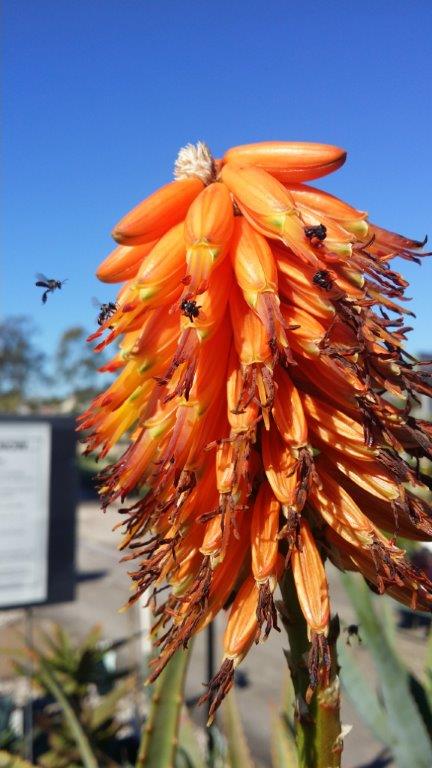
Native stingless bees love the winter flowering ornamental aloes
The average annual minimum for a subtropical zone is 6º C (43º F). Winter days are mostly in the very comfortable mid 20 degrees C (mid 70 degrees F) so the weather is ideal now for growing almost anything. We are having a short respite from the extreme heat and humidity of our very long summers, and gardeners rejoice and plant!
Winter in a subtropical garden can be glorious and delightful. Gardeners, animals and plants alike bask in the sun as if on holiday and, for this short time of year, we can actually enjoy the sunshine instead of hiding from it. I feel like a teenager falling in love with my garden anew each day right now.
This is typically our dry season. We do get rain and sometimes a fair bit but usually it comes down with a little less force than the summer storms and so is more gentle on new plants. Even when we don’t get the rain, we often get heaven dew which is enough to encourage seeds to germinate and seedlings to enjoy the warm sunny days and grow quickly.
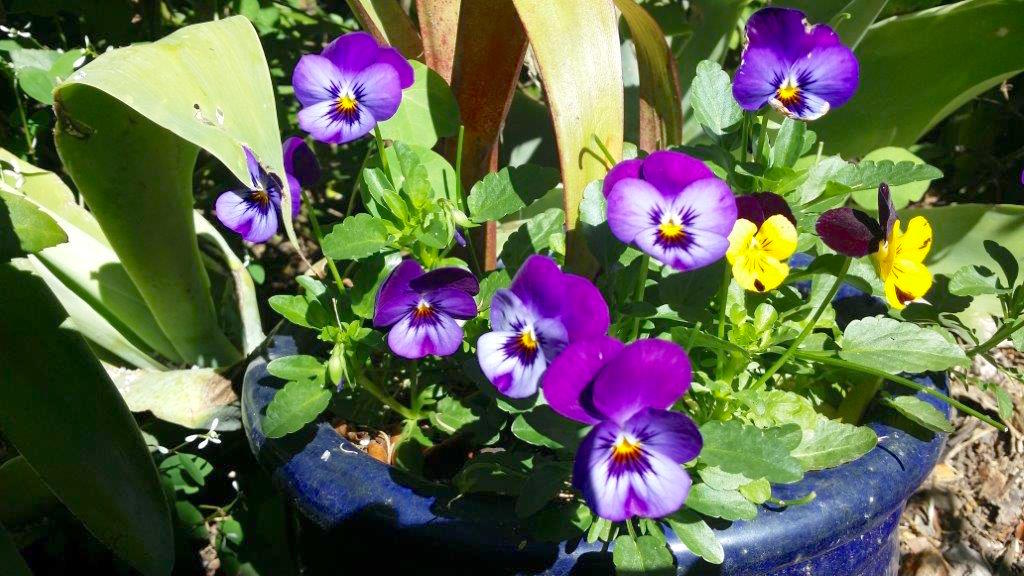
Happy viola faces really brighten up a winter garden
So well, in fact, that winter is a significant growing season here in the subtropics. Most vegetables are grown over winter here as summers are too hot, humid and there are too many fruit flies. Luckily the weather is still warm enough to enjoy eating salads as we grow most of our leafy green salad leaves in winter. GardenDrum author Arno King has recently given me some Malaysian lettuce which he assures me will provide salad greens right through summer. I am looking forward to that but for now we are spoilt for choice with a wealth of fresh delightful greens – both vegetables and edible weeds. Chickweed, one of my favourite salad greens, is at its best right now.
Now is also the time for ‘spring’ annuals. Spring here can be very hot and dry, so the tender pansies, stock, snap dragons, primulas etc can give up pretty quickly, but they are putting on a great show now in the dead of winter. If you have not planted seeds yet, get seedlings in now, as it is not too late for a good winter show.
No, in the subtropics we don’t have a ‘dead of winter’; it is an amazingly alive time of year (says I with a king parrot peeking around the corner of my screen to see what I am writing!).
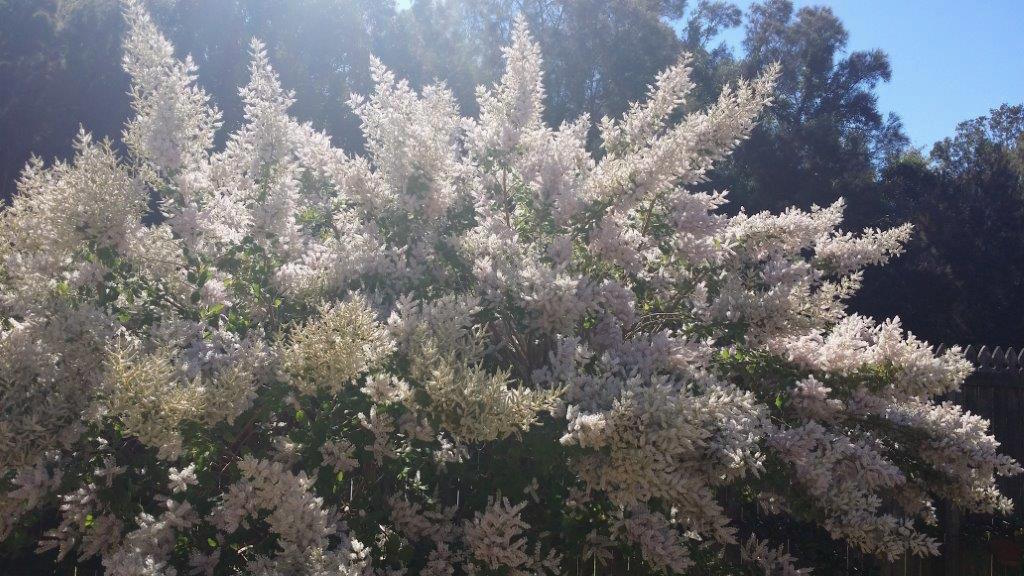
Tetradenia riparia syn. Iboza is a prolific winter flowerer in the subtropics
There are not as many pests about and yet going into the garden there are bees galore. The dombeya and Iboza (now Tetradenia) are flowering and I have never seen such a mass of bees, except for this time last year.
The cobblers pegs, emelia and clover are flowering away in an abandoned lot over the road. When I took a group over for a weed foraging workshop recently they were all surprised at how many bees were on them, and at the huge variety of bees, butterflies and other ‘buzzing things’ that were enjoying the abundance of flowers on the weeds in mid-minter.
Now is the perfect time to plan and plant a new garden particularly one that will be located in a sunny place. Do the soil prep in the heat of summer as compost rots quickly then, but plant new plants in winter. Now, in winter, the weather is gentle on tender new plants. Get as many new plants in as you can to get established before the heat of summer arrives.
A lot less water is needed to establish new plants at this time of year, but good watering practices are always important. Don’t overwater now as this will lead to rotting as plants are not transpiring as much. Do water the entire root zone, don’t just splash the surface. Deeper watering encourages deeper roots and makes plants much better able to withstand the hot and dry times.
Watering in the mornings rather than the evenings is a good idea now too. The magic number here is 15º C (60º F). Once the nights drop below 15º C water in the mornings to allow the plants to take this water up while temperatures are warm enough for them to do so. Below 15º C the plants end up sitting in cold wet soil over night. For those of us who like the warmth, this is not an appealing idea.
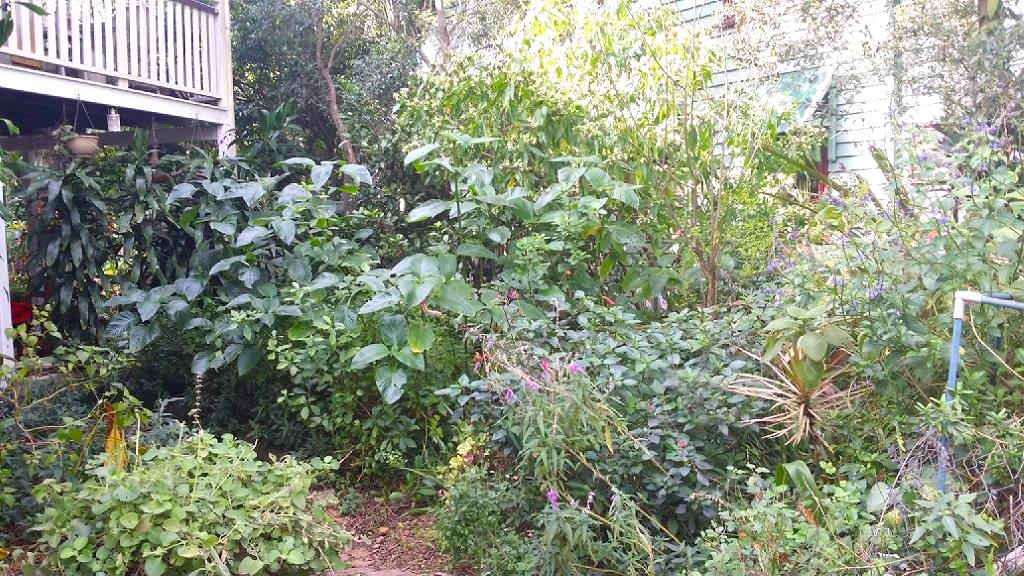
This part of my garden gets no sun at all in winter and yet plenty in summer
When planning and planting a new garden in winter, be aware of where the summer sun is. It can be very different now as the sun is much lower in the sky and the shadows cast by trees and buildings deeper. This may mean that an area is in full shade now, but by mid summer may well be in full sun. Choosing plants for these areas can be tricky. As long as the plants can tolerate a short period of shade, they will last the winter.
As our winters are short – much shorter than our long hot summers, I recommend planting for summer success. Many plants will not be at their best in the shade and would die there if that was all year round, but they tend to come good when the brightness of summer arrives. A garden I visit has two Loropetalum (fringe flower). The client was asking why the one in the front was looking so sad lately. It spends winter in fairly deep shade, which it is not thrilled by. The one at the back is in a pot and looking sensational right now, where it is getting full winter sun. In mid-summer it is the opposite. The plant in the front gets some direct sun but otherwise bright shade and flourishes, the one at the back needs a lot of additional watering to keep it happy.
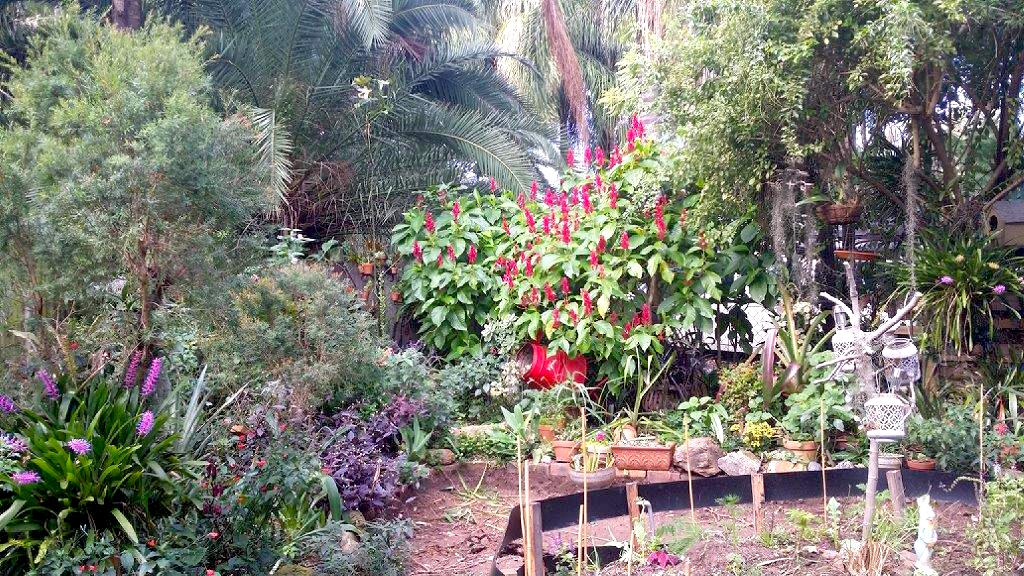
Brazilian Red Cloak (Megaskepasma) in the back in flower, in the foreground the part if the garden being created in the freshly dug up back lawn
In my garden a patch like this does well with cats whiskers, brilliantasia, cordyline, asystasia, and more. Even the Brazilian red cloak (Megaskepasma) gets very little sun now but is flowering beautifully. One trick for choosing plants for such spaces is to choose plants that flower in summer and autumn. This allows them plenty of sunshine to encourage flowering, and a shorter shady time when they are not trying to set flowers. If you plant winter and spring flowering plants you may find they don’t put on much of a show as they are not getting enough light at the right time to set flowers. I have good success this way with Mexican sage. It gets lots of summer sun, flowers beautifully in autumn, then gets lots of winter shade. It still has some flowers on it now, but is finishing and due for a hard prune now.
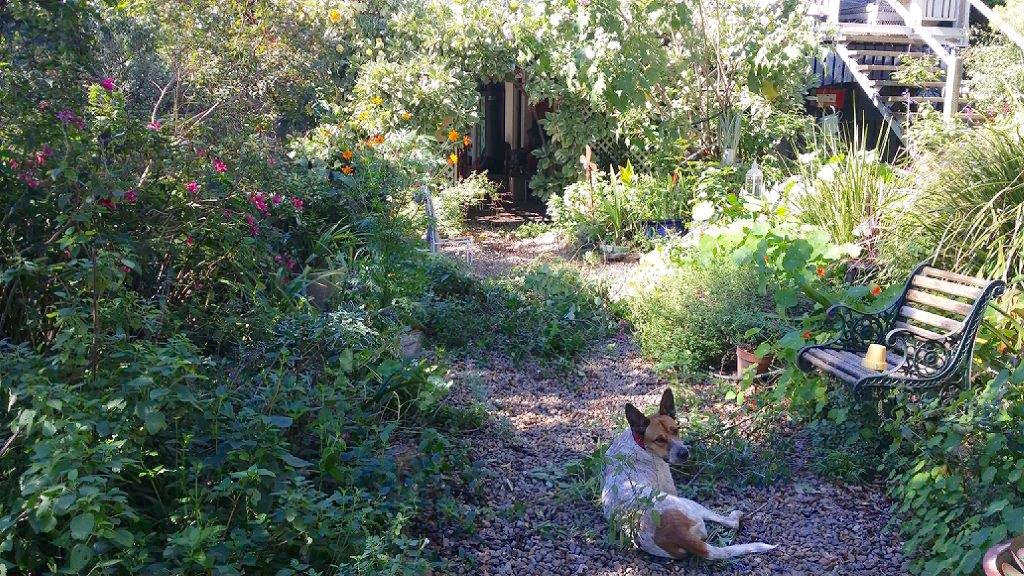
One of the dogs helping me with a big winter prune. The sun and shade in this garden varies enormously at different times of the year and yet it is never without flowers
Frangipanis can also be great for these sort of spots. I have a lovely pink one (well I have half a lovely pink one since Cyclone Debbie came through in March) which gets full summer sun and flowers beautifully, but in winter gets very shaded. It is dormant now and has no leaves so does not mind being in shade.
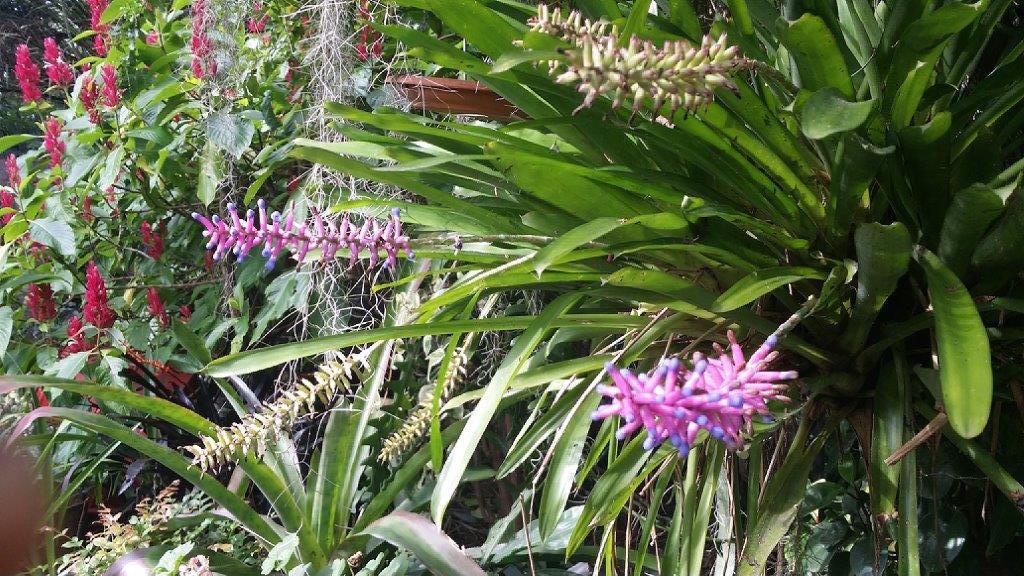
The winter sun is low enough to shine in on these bromeliads in time for them to flower
At the opposite end of this are the plants which love the summer shade but are flowering now with some winter sun, like some of the bromeliads. The lower angle of the sun at this time of year can send soft shards of light deeper under a tree canopy giving these plants the extra light to flower well at just the right time. At this time of year the lower sun sends the most beautiful dappled light into a very shady area of my garden and it is alive with the magenta of Peristrophe and white Eucharist lilies, although these would be happily flowering now even in full winter shade.

Pristine Eucharist lily
My dear husband has decided it is time I had a new garden bed so he has dug up the back lawn (he would never have done that willingly in summer!) and made me a new garden bed which I am busy filling with seeds and seedlings of herbs, flowers, weeds (in case I lose my abandoned weedy house lot over the road!) and Arno’s Malaysian lettuce. Bits of prunings are being plonked in all over the place. As the weather warms up I will forget what I have put where as I will be too hot to be poking around in my own garden so much after work, and I will be pleasantly surprised by what I find – things that I have planted now and in the midst of summer they will be standing tall and taking their place in the garden.
Our seasonal changes are great enough to be enjoyed here but can certainly not be considered extreme. We don’t get severe frosts or snow, the ground never freezes and we can grow all year round. But subtropical gardeners can certainly get very busy in the garden now and rejoice in this delightful weather!
